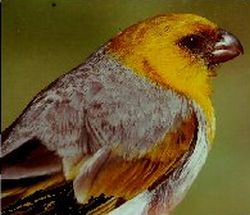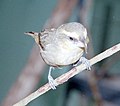Clothes birds
| Clothes birds | ||||||||||||
|---|---|---|---|---|---|---|---|---|---|---|---|---|

Iiwi ( Drepanis coccinea ) |
||||||||||||
| Systematics | ||||||||||||
|
||||||||||||
| Scientific name | ||||||||||||
| Drepanidini | ||||||||||||
| Cabanis , 1847 |
The clothes Birds (Drepanidini) are a tribe from the family of finches (Fringillidae), before they were classified as a separate subfamily Drepanidinae, today they are within the Stieglitz-like (Carduelinae). Their habitat is the Hawaiian island chain. Of the 34 species, around half are already extinct; the rest are either threatened with extinction or endangered.
features
Honeysuckle are between 10 and 20 cm long and have wingspans of 15 to 30 cm. Their beaks are more or less bent downwards. The species are usually divided into two groups: the nectar-eaters and the seed-eaters.
Nectar eater


The plumage of the nectar eater is mostly black-red in color, with the tail and rear wing feathers being black and the rest of the plumage being red. The beak is long and sometimes very curved. The Hawaiian Akialoa has the longest beak , whose beak measures about half as much as the body. The tongues of the nectar eater are tubular in order to suck the nectar out of the flowers.
Seed eater
Seed eaters have short and less curved beaks. The plumage is mostly green, yellow or grayish, only very rarely dark, colored. Their appearance is often reminiscent of domestic finches such as the greenling .
Reproduction
There are hardly any differences between nectar-eaters and seed-eaters in terms of reproduction . The pairs can already be found in October, although the courtship and breeding season takes place between December and July. After mating, the female lays 2–3 white or bluish eggs with red-brown spots in a shallow bowl nest, which is mostly on trees, but sometimes also in tall grass. After an incubation period of 3–4 weeks, the young hatch and are fed by both parents. Most species become sexually mature when they are one year old.
food
The nectar eaters mainly feed on nectar , but also on insects, caterpillars, spiders and larvae, which they pull out from under the tree bark with their long beaks. Seed eaters are essentially limited to grass and tree seeds .
Spread and threat

All 34 species of honeycreeper live or lived in the Hawaiian Islands. 13 species have become extinct, and 11 more are directly threatened with extinction. The rest are also at risk in the long term. The greatest enemy is probably humans, who penetrate deeper and deeper into the dense forests, destroying them and thus depriving the birds of their habitat. Tree rats and other egg thieves also ensure that the population is getting smaller and smaller. In addition, the stocks are being decimated by diseases such as birdpox and bird malaria . Most species only occur at higher altitudes - above 1250 to 1500 m above sea level - in sufficient population densities, since at these altitudes the mosquito Culex quinquefasciatus , which transmits malaria , is rare . The survival of honeysuckle birds on the islands of Kauai , Oahu , Molokai and Lanai , which do not reach this altitude or only slightly exceed it, is particularly problematic .
Since the Palila ( Loxioides bailleui ) is dependent on the pearl-string tree and this only grows on the slopes of Mauna Kea , the Palilas live almost exclusively in this area; however, earlier they were common all over Hawaii. The exact number of stocks can only be roughly estimated as some parts of the Hawaiian Islands are difficult to access.
Genera and species (selection)
The heather birds include 34 species, all believed to be descended from a single species whose members went off course and became native to Hawaii . It is believed that this species possessed a tongue suitable for drinking nectar and a short beak.
-
Telespiza
- Laysan pimple ( Telespiza cantans ), endemic to Laysan
- Nihoa pimple ( Telespiza ultima ), endemic to Nihoa
- † Telespiza ypsilon , subfossil on Maui and Molokai.
-
Psittirostra
- Ou ( Psittirostra psittacea )
- † Dysmorodrepanis
- † Lanai hookbeak ( Dysmorodrepanis munroi )
-
Loxioides
- Palila ( Loxioides bailleui )
- † Kauai Palila ( Loxioides kikuchi ) subfossil on Kauaʻi
- † Rhodacanthis
- † Little Koafink ( Rhodacanthis flaviceps )
- † Great Koafink ( Rhodacanthis palmeri )
- † Chloridops
- † Kona finch ( Chloridops kona )
- † Chloridops regiskongi subfossil on Oahu.
-
Pseudonestor
- Parrot-billed finch ( Pseudonestor xanthophrys )
-
Hemignathus - 11 species, including 5 †
- † Oahu Akialoa ( Hemignathus ellisianus )
- Oahu Amakihi ( Hemignathus flavus )
- Kauai Amakihi ( Hemignathus kauaiensis )
-
Nukupuu ( Hemignathus lucidus )
- Maui Nukupuu ( Hemignathus lucidus affinis )
- Oahu Nukupuu ( Hemignathus lucidus lucidus )
- Kauai Nukupuu ( Hemignathus lucidus hanapepe )
- † Hemignathus vorpalis subfossil in Hawaii
- Akiapolaau ( Hemignathus munroi )
- † Hawaiian Akialoa ( Hemignathus obscurus )
- Anianiau ( Hemignathus parvus ) (now in its own genus Magumma parvus )
- † Hermit green-clad bird ( Hemignathus sagittirostris )
- † Hemignathus upupirostris
- Amakihi ( Hemignathus virens )
- Oreomystis
-
Paroreomyza
- Maui Branch Runner ( Paroreomyza montana )
- † Kakawahie ( Paroreomyza flammea )
- Oahu branchcreeper ( Paroreomyza maculata )
-
Akepa-covered birds ( Loxops )
- Akekee ( Loxops caeruleirostris )
-
Hawaiian Akepa hawk bird ( Loxops coccineus )
- Hawaiian Akepa hawk bird ( Loxops coccineus coccineus )
- † Oahu Akepa hawk bird ( Loxops coccineus wolstenholmei )
- † Maui Akepa hawk bird ( Loxops ochraceus )
- † Ciridops
- † Anna's clothes bird ( Ciridops anna )
- Mamos ( Drepanis )
-
Palmeria
- Crested bird ( Palmeria dolei )
-
Himatione
- Apapane ( Himatione sanguinea )
- † Laysan apapane ( Himatione freethii )
-
Melamprosops
- White-cheeked honeycreeper ( Melamprosops phaeosoma ) (presumably extinct after the last male died in human care on November 28, 2004 and this species was no longer detected in the wild.)
Fossil is known to the genus Vangulifer .
Picture gallery
literature
- Oxford University Press: The Hawaiian Honeycreepers: Drepanidinae (Bird Families of the World) . 2005, ISBN 0-19-854653-X .
Individual evidence
- ^ Taxonomy . In: J. del Hoyo, A. Elliott, J. Sargatal, DA Christie & E. de Juana, E. (Eds.): Handbook of the Birds of the World Alive . Lynx Edicions, Barcelona ( hbw.com [accessed August 23, 2018]).



